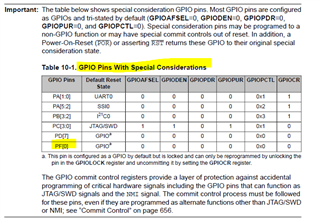My code below detects SW1 - but doesn't detect SW2 - but think I'm configuring both the same ...
Not sure what I'm missing here
SysCtlPeripheralEnable(SYSCTL_PERIPH_GPIOF);
GPIOPinTypeGPIOInput(GPIO_PORTF_BASE, GPIO_PIN_4); // SW1
GPIOPinTypeGPIOInput(GPIO_PORTF_BASE, GPIO_PIN_0); // SW2
GPIODirModeSet(GPIO_PORTF_BASE, GPIO_PIN_4, GPIO_DIR_MODE_IN);
GPIODirModeSet(GPIO_PORTF_BASE, GPIO_PIN_0, GPIO_DIR_MODE_IN);
GPIOPadConfigSet(GPIO_PORTF_BASE, GPIO_PIN_4,
GPIO_STRENGTH_2MA, GPIO_PIN_TYPE_STD_WPU);
GPIOPadConfigSet(GPIO_PORTF_BASE, GPIO_PIN_0,
GPIO_STRENGTH_2MA, GPIO_PIN_TYPE_STD_WPU);
int32_t SWstatus=GPIOPinRead(GPIO_PORTF_BASE,
GPIO_PIN_4|GPIO_PIN_0)^17;


